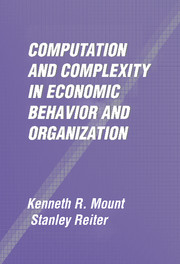Book contents
- Frontmatter
- Contents
- Acknowledgments
- 1 Introduction
- 2 F Networks
- 3 Networks of Real-Valued Functions
- 4 Applications to Economics
- 5 Applications to Games
- 6 Lower Bounds and Approximations
- 7 Organizations
- A Appendix to Chapter 2: Graph Theory
- B Appendix to Chapter 3: Real-Valued Functions
- C Appendix to Chapter 5: Application to Games
- Bibliography
- Index
3 - Networks of Real-Valued Functions
Published online by Cambridge University Press: 04 June 2010
- Frontmatter
- Contents
- Acknowledgments
- 1 Introduction
- 2 F Networks
- 3 Networks of Real-Valued Functions
- 4 Applications to Economics
- 5 Applications to Games
- 6 Lower Bounds and Approximations
- 7 Organizations
- A Appendix to Chapter 2: Graph Theory
- B Appendix to Chapter 3: Real-Valued Functions
- C Appendix to Chapter 5: Application to Games
- Bibliography
- Index
Summary
THE LEONTIEF THEOREM
In Chapter 1 we presented the concept of the (time) complexity of a function in an network model of computing. In this chapter we analyze the complexity of a function, or obtain bounds on its complexity. It is shown in Chapter 2 that when the class of elementary functions consists of Boolean functions the network model specializes to the finite-automaton model of computing. The network model is also related to an approach to computing and complexity called nomography (Bieberbach, 1922) that was pursued in mathematics from the late 19th into the mid-20th centuries. In this chapter we use some results from that literature to analyze the complexity of functions in the network model. Thus, the network model serves as a bridge connecting finite-automaton theory to classical mathematics – a connection we will emphasize below, when we consider the complexity of finite approximations of smooth functions (cf. Chapter 5).
A simple case to start with is that of networks. The class is the collection of real-valued differentiable functions of one real variable. The class contains no functions that can be used to reduce the n(>1) variables {x1, …, xn} to a single real variable. Whether a function G can be computed by an network can be decided by simply counting the number of variables of G. If n = 1, so that G is a function of one variable, and if g is some subset of, the time required to compute G by a G network can be very difficult to determine.
- Type
- Chapter
- Information
- Publisher: Cambridge University PressPrint publication year: 2002

